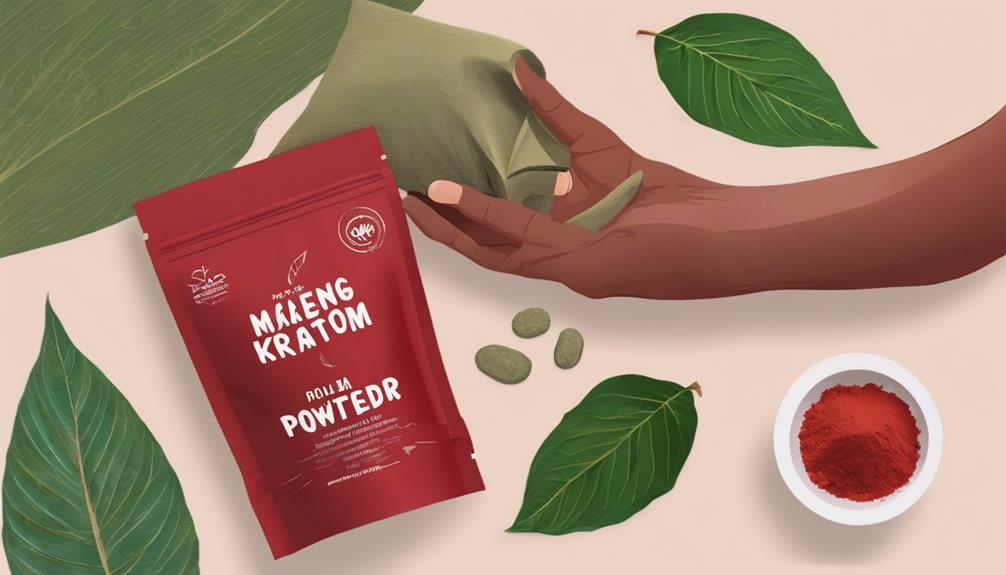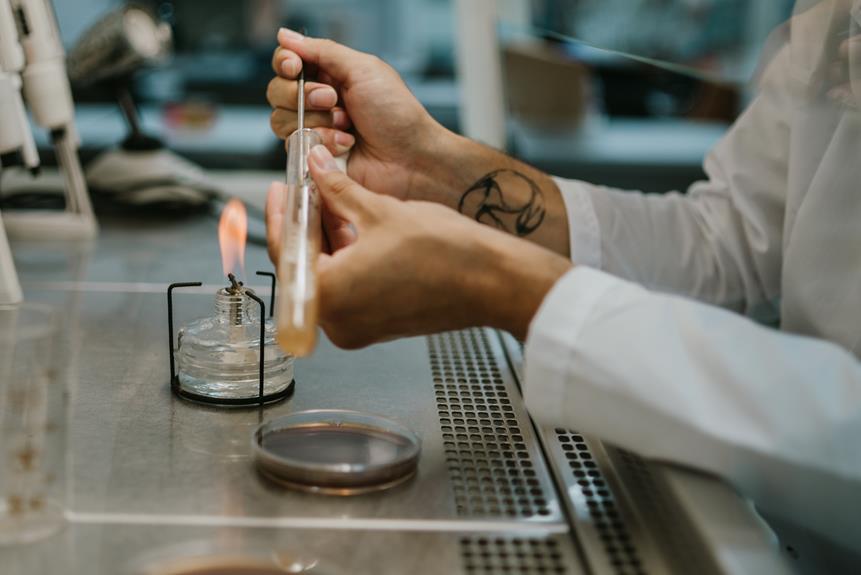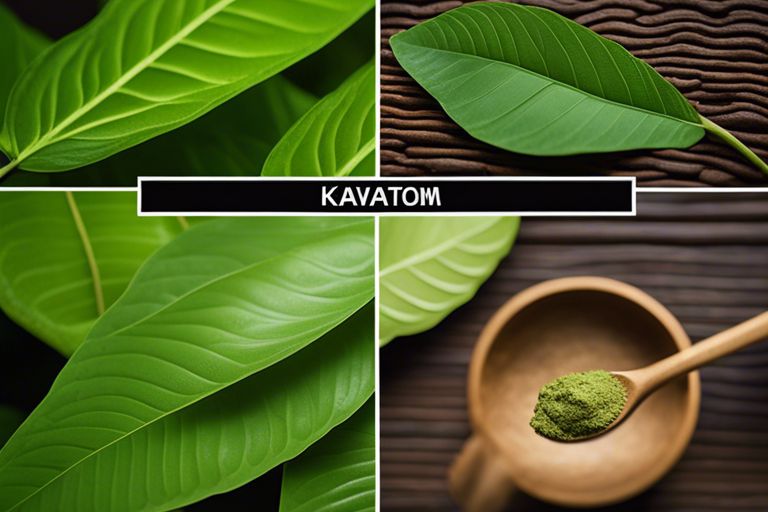Deprecated: mb_convert_encoding(): Handling HTML entities via mbstring is deprecated; use htmlspecialchars, htmlentities, or mb_encode_numericentity/mb_decode_numericentity instead in /home/users/kratomfiles/www/kratomfiles.com/wp-content/plugins/quick-adsense-reloaded/includes/template-functions.php on line 3552
When comparing Kratom and Kava Kava, it is crucial to acknowledge their distinct origins, active components, and effects on the body. These differences go beyond just the surface and can impact your choices greatly. Understanding the nuances between these two herbal remedies could lead to more informed decisions regarding their consumption. Explore the intricate details that set Kratom and Kava Kava apart, and discover which one might align better with your needs and preferences.
Key Takeaways
- Kratom contains alkaloids interacting with opioid receptors for pain relief and stimulation.
- Kava Kava's kavalactones induce sedative effects through GABA interaction.
- Kratom is known for potential pain relief and energy boost, while Kava consistently produces calming effects.
- Kratom faces legal bans in several U.S. states and countries like Thailand and Malaysia.
- Kava Kava is traditionally used for relaxation, stress reduction, and anxiety relief, with fewer legal restrictions compared to Kratom.
Origins and Plant Families
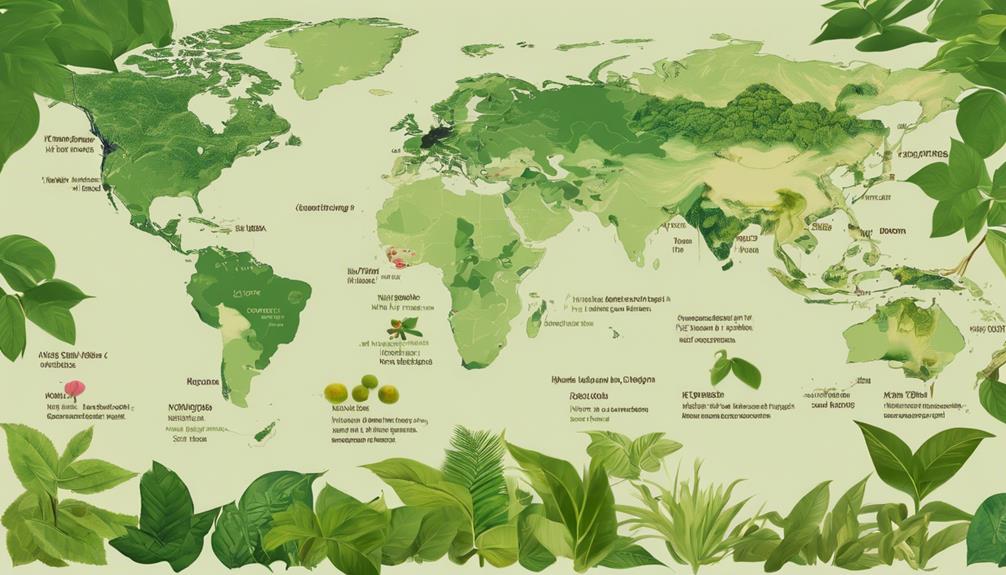
When delving into the origins and plant families of Kratom and Kava Kava, it is essential to understand their distinct botanical backgrounds to grasp their unique characteristics and effects. Kratom, originating from the Mitragyna speciosa plant in Southeast Asia, belongs to the coffee family, Rubiaceae. On the other hand, Kava Kava is derived from the Piper methysticum plant native to the South Pacific islands and is a member of the pepper family, Piperaceae.
The difference in origins between Kratom and Kava Kava is not merely geographical but also botanical. The plant families they belong to play a significant role in shaping their properties. Kratom's association with the coffee family hints at its stimulating and energizing effects, similar to caffeine. In contrast, Kava Kava being part of the pepper family suggests a more calming and sedative nature, in line with its traditional use as a relaxant in the South Pacific islands.
Understanding the origins and plant families of Kratom and Kava Kava provides valuable insights into the distinct nature of these botanicals and sets the foundation for comprehending their diverse effects.
Active Components and Alkaloids
When comparing kava and kratom, understanding their active components and alkaloids is essential. Kava contains kavalactones that induce sedative effects through GABA interaction, while kratom's alkaloids like mitragynine interact with opioid receptors, resulting in varied stimulant and sedative effects. These chemical differences play a significant role in the distinct pharmacological effects each plant has on the body.
Chemical Composition Differences
What sets kava apart from kratom regarding their chemical composition and active components? Kava's chemical composition includes kavalactones that interact with GABA receptors, promoting relaxation and calmness. In contrast, kratom contains alkaloids like mitragynine and 7-hydroxy mitragynine, which act on opioid receptors, providing pain relief and stimulation. The distinction lies in how these components affect the body; kava's kavalactones are non-addictive, while kratom's alkaloids can lead to dependence. Understanding the nuances of the chemical makeup of kava and kratom sheds light on their diverse effects on the central nervous system. It is essential to grasp the active components in each plant to evaluate their potential benefits and risks accurately.
Effects on the Body
The active components present in kava and kratom play a pivotal role in determining the effects these plants have on the body. Kava's kavalactones interact with the GABA neurotransmitter, inducing sedative effects, promoting relaxation and stress relief without the risk of addiction. On the other hand, kratom's alkaloids, such as mitragynine and 7-hydroxy mitragynine, interact with opioid receptors, leading to stimulant or sedative effects. While kava primarily induces sedation, kratom offers stimulating or sedative properties. Recognizing that kava's components are less likely to cause addiction or dependence compared to kratom, whose alkaloids can lead to dependence due to their interaction with the brain's opioid receptors. Understanding these differences is essential when considering the effects of these plants on the body.
Pharmacological Effects
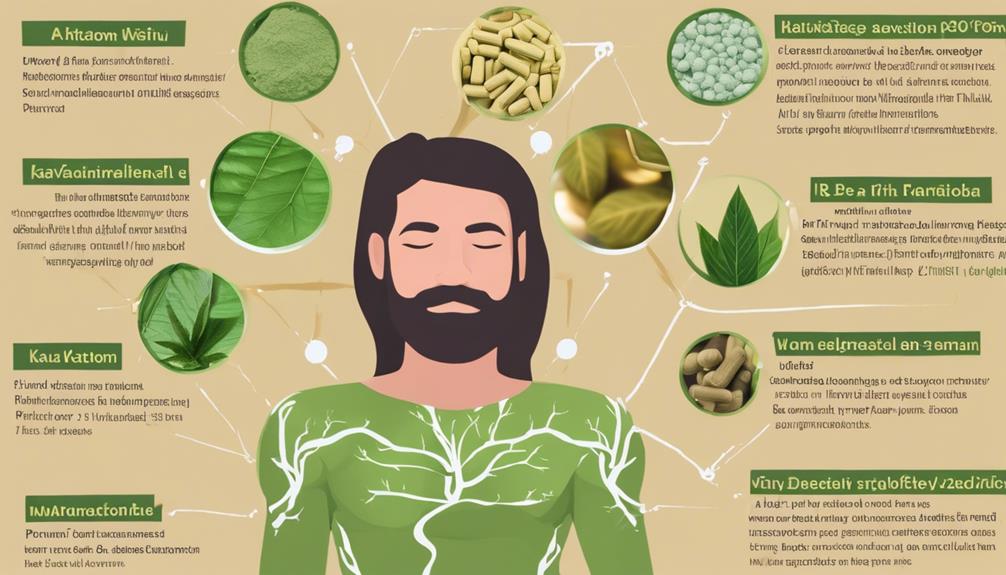
When assessing the pharmacological effects of Kratom and Kava Kava, it is essential to take into account their distinct impacts. Kratom is known for its potential pain relief properties, while Kava Kava consistently produces calming effects. Additionally, Kratom can offer an energy boost depending on the dosage consumed.
Kratom Pain Relief
Kratom's pain-relieving effects stem from the interaction of alkaloids like mitragynine and 7-hydroxy mitragynine with opioid receptors in the brain, offering a comparable alternative to traditional opioids for chronic pain management. These alkaloids in kratom bind to the mu-opioid receptors, producing analgesic effects similar to opioids. By modulating pain pathways, kratom can help manage various types of pain, from acute to chronic conditions. Despite similarities to opioids, kratom's distinct mechanism of action may lead to a lower risk of respiratory depression, a common side effect of traditional opioids. Understanding how kratom interacts with the body's pain pathways is essential for individuals seeking natural alternatives for pain relief, highlighting the importance of informed and responsible kratom use.
Kava Calming Effects
Kava's calming effects, attributed to its kavalactones interacting with neurotransmitters like GABA in the brain, offer a natural alternative for reducing anxiety and promoting relaxation. The kavalactones in kava play a significant role in its pharmacological effects, which include alleviating anxiety and enhancing sleep quality. This herb's ability to induce a state of relaxation without causing sedation sets it apart from traditional sedatives or alcohol, making it a preferred choice for stress relief. In various cultures, kava is utilized for social bonding and relaxation during ceremonies. Studies indicate that kava's calming properties are on par with some prescription medications designed to manage anxiety and stress. Embracing kava for its calming effects can provide a gentle yet effective approach to finding tranquility amidst life's challenges.
Kratom Energy Boost
When considering individuals seeking a natural energy boost, it is crucial to recognize that kratom's pharmacological effects, driven by its alkaloids such as mitragynine and 7-hydroxy mitragynine, provide a stimulating alternative akin to caffeine but with more sustained results. These alkaloids interact with adrenergic and serotonergic receptors in the brain, enhancing alertness and energy levels. Kratom's stimulant properties deliver a surge of energy that users often describe as increasing focus, motivation, and mental sharpness. Unlike the quick peak and crash sometimes associated with caffeine, kratom offers a smoother and longer-lasting energy boost. It should be noted that the specific energy-boosting effects of kratom can vary depending on the strain and dosage consumed, with certain strains offering more potent energizing effects than others.
Interaction With Neurotransmitters
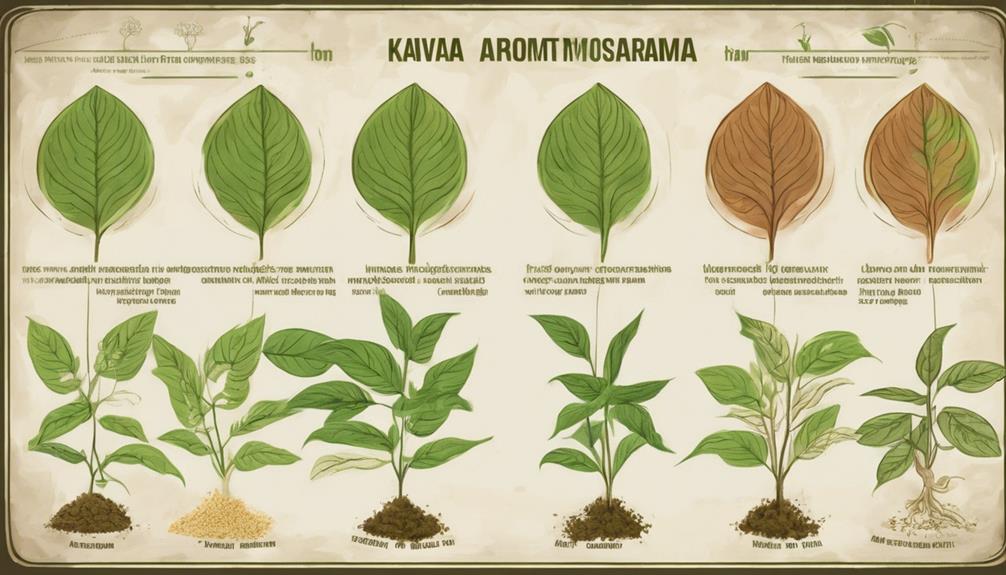
When examining the interaction of these herbal substances with neurotransmitters, it becomes apparent that each plays a significant role in modulating bodily responses. Kava primarily interacts with the GABA neurotransmitter, known for its calming effects. This interaction in kava leads to relaxation without causing sedation or addiction potential, making it a popular choice for those seeking a calming experience. On the other hand, kratom interacts with opioid receptors, affecting mood and pain perception. This interaction can result in a range of effects from stimulation to sedation, depending on the strain and dosage used.
Understanding how kava and kratom interact with neurotransmitters is important for predicting their effects on the body. While kava's focus on GABA leads to relaxation and calmness, kratom's impact on opioid receptors can bring about a broader spectrum of effects. By recognizing these distinct pathways, individuals can make more informed decisions about which herbal substance aligns best with their desired outcomes.
Sedative Vs. Stimulant Properties
With distinct properties that set them apart, kava and kratom offer users contrasting experiences when it comes to sedation and stimulation. Kava is renowned for its sedative qualities, promoting relaxation and tranquility, making it ideal for unwinding after a long day or socializing in a relaxed setting. On the other hand, kratom acts as a stimulant, providing users with increased energy and heightened focus, often used to kickstart the day or enhance productivity.
To further highlight the differences between the sedative and stimulant properties of kava and kratom, let's take a look at the following table:
| Property | Kava | Kratom |
|---|---|---|
| Sedative | Known for sedative effects | Acts as a stimulant |
| Stimulant | Provides relaxation and calmness | Offers energy and focus |
| Common Use | Social bonding and stress relief | Pain relief and recreational use |
The contrasting effects of kava's sedative nature and kratom's stimulating properties cater to individuals seeking distinct outcomes, whether it be relaxation and stress relief or increased energy and focus.
Geographical Distribution and Cultivation

Kratom and Kava Kava have distinct geographical origins and cultivation methods. Kratom is indigenous to Southeast Asia, flourishing in countries like Malaysia, Thailand, and Indonesia, whereas Kava Kava hails from the South Pacific islands, specifically grown in regions like Fiji, Vanuatu, and Hawaii. Understanding where and how these plants are cultivated sheds light on their traditional uses and effects in various cultures.
Geographic Distribution Overview
Originating from distinct regions, kava and kratom have divergent geographic distributions that greatly shape their cultivation practices and cultural importance. Kava, native to the South Pacific islands, is primarily cultivated in countries like Fiji, Vanuatu, and Tonga. On the other hand, kratom originates from Southeast Asia and is found in regions like Thailand, Indonesia, and Malaysia. The geographical distribution of these plants influences their traditional uses and cultural significance in their respective regions. Below is a table summarizing the geographic distribution, traditional uses, and legal challenges faced by kava and kratom:
| Aspect | Kava | Kratom |
|---|---|---|
| Geographic Distribution | South Pacific islands | Southeast Asia |
| Traditional Uses | Cultural ceremonies, relaxation | Pain relief, energy boost |
| Legal Challenges | Limited legal restrictions | Legal challenges in Southeast Asia |
Cultivation Methods Explained
Cultivation practices for kava and kratom differ greatly due to their distinct geographic distributions, impacting how these plants are grown and harvested. Kratom is mainly cultivated in Southeast Asia, encompassing countries such as Thailand, Malaysia, Indonesia, and Vietnam. The tropical climates and fertile soil in these regions provide an ideal environment for kratom trees, with different strains favoring specific conditions. On the other hand, kava kava is primarily grown in the South Pacific islands, including Fiji, Vanuatu, Tonga, and Hawaii. Kava plants thrive in volcanic soil, with various strains adapted to different island settings. The geographical distribution of cultivation significantly influences the availability and diversity of kratom and kava products in the market, showcasing the importance of understanding their unique cultivation methods.
Legal Status and Regulations
Given the changing legal landscape, it is important to explore the regulations governing the accessibility and usage of Kratom and Kava Kava. Kratom faces bans in various U.S. states and has been prohibited in countries like Thailand and Malaysia due to safety concerns raised by regulatory bodies. Conversely, Kava enjoys a more vital legal status, remaining legal and unregulated in many regions. The FDA has expressed worries regarding the safety of kratom, leading to import bans and heightened scrutiny. This underscores the stark regulatory disparities between kratom and kava, with the former encountering increasing restrictions while the latter garners global acceptance as a safe herbal product. Understanding the legal frameworks and regulations surrounding these substances is essential for individuals seeking to make informed choices about their usage. Stay informed about the evolving legal landscape surrounding kratom and kava to ensure compliance and safety in their consumption.
Traditional and Modern Uses

Traditionally in the South Pacific, Kava Kava has been utilized for relaxation and as part of social bonding rituals. The plant's roots are prepared into a drink that induces a sense of calm and tranquility, making it a popular choice for ceremonies and gatherings. In modern times, Kava Kava has expanded its traditional use to include stress reduction, anxiety relief, and even aiding in sleep. Its natural properties make it a sought-after remedy for those looking to unwind and find a moment of peace in a fast-paced world.
On the other hand, Kratom, traditionally used in Southeast Asia for pain relief and energy, has found its place in modern wellness practices for different reasons. Today, Kratom is commonly used for recreational purposes, mood enhancement, and even managing opioid withdrawal symptoms. Its versatile nature has led to a broad spectrum of applications, appealing to individuals seeking various benefits beyond its traditional roots.
Potential Risks and Side Effects
Moving from the discussion of their traditional and modern uses, both kava and kratom present potential risks and side effects that necessitate careful consideration when incorporating them into wellness practices. Kratom, due to its interaction with opioid receptors, can lead to addiction and dependence, manifesting in physical and mental opioid side effects. Overdosing on kratom may result in symptoms like nausea, vomiting, dizziness, and seizures, highlighting the importance of understanding proper dosages. On the other hand, kava has been linked to liver damage, skin rashes, and neurological issues when used excessively or for prolonged periods. Cases of hepatotoxicity have been reported with high doses or extended use of kava, underscoring the need for moderation. Both substances carry potential risks, emphasizing the significance of informed and responsible consumption to mitigate adverse physical and mental effects. Prioritizing awareness of these potential side effects is essential for fostering safe and beneficial outcomes in your wellness journey.
How does the energy from Kratom compare to the effects of Kava Kava?
When comparing the effects of Kratom and Kava Kava, it’s important to note that top kratom energy strains tend to provide a more stimulating and energizing effect, while Kava Kava is known for its calming and sedating properties. It’s essential to understand the differences between these two natural remedies before incorporating them into your wellness routine.
Addiction and Dependency Factors

With its interaction with opioid receptors, kratom poses a significant risk of addiction and dependency, highlighting the importance of cautious consumption practices. Unlike kava, which is not linked to addiction or dependence, kratom's addictive potential is a cause for concern. Continued and high-dose use of kratom can elevate the chances of developing a dependency on the substance, necessitating attention to safe consumption levels.
Individuals grappling with kratom addiction can seek support through specialized treatment programs tailored to address the challenges associated with this specific type of addiction. Responsible usage, coupled with an understanding of the risks involved and adherence to safe dosage guidelines, is essential in managing the potential for addiction associated with kratom. By being informed and mindful of these risks, individuals can take proactive steps towards mitigating the dangers of opioid addiction and dependency, thereby promoting healthier and safer consumption practices.



